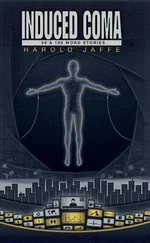It was silent, everyone’s attention completely riveted on Curtis. “You’ll be exposed to things that make you uncomfortable, and some things that make you very uncomfortable. You’ll be in the bathroom with your Subjects. You’ll shower with them, go on dates with them, get busy in the backseats of cars with them. Some Minders choose to treat those ‘intimate’ moments as free time, to catalogue the impressions from their day or week mentally, giving the Subject time “alone.” Others use them as a marker of their Subject’s behavior at moments of intense sensation. Everyone approaches and experiences Syncopy in different ways. But one thing is universal.”
Curtis’s eyes met Sadie’s again, and she felt like he was speaking directly to her. “The experience of Syncopy will test you. It will push the limits of your experience, comfort, and patience. It will make you feel more powerless than you ever have before. It will overwhelm you. It may terrify you. You won’t be disappointed.”
Around her there was a scattering of nervous laughter, breaking the spell of his gaze, and Sadie realized she’d been holding her breath.
“For all this magic to happen,” he went on, his eyes moving from one side of the group to the other, “your body must be put in stasis. We’ll start you in a shallow stasis for a week so we can monitor you closely and fine-tune the connection between your Subject’s signal and your brainwaves.”
A hand went up near the front of the room, and a girl asked, “What is the difference between shallow stasis and deep stasis?”
“It’s like the difference between ducking your head under water in a bathtub and submerging yourself in the middle of a lake,” Curtis explained. “We’ve found that the initial jump into Syncopy can be overwhelming, so to minimize that disorientation and maximize your ability to work productively from day one, we suppress certain sensory inputs, such as taste and temperature. In shallow stasis you also have access to a panic button that makes it possible for you to exit Syncopy easily and safely if necessary.”
A guy with hair that appeared to have been parted by a ruler asked, “Why would we panic?”
Curtis chuckled. “Right. You’re not a group prone to panic.” Sadie felt herself nodding instinctively and, glancing around, saw that everyone else was too. “That’s exactly why. Syncopy is unidirectional. That means all you can do is witness. You won’t be able to talk or move or advise or offer suggestions. To say that your hands will be tied is an understatement. You will not have the ability to communicate or influence events in any way. Hours can feel like days, days like years, when you are in someone else’s control.”
The group went completely still.
“Everyone will be brought out of stasis at the end of the first week and interviewed,” Curtis went on. “If the Committee is satisfied with your performance, you will move from shallow to deep stasis for the remainder of the six weeks. At that point—”
A girl with her hair pulled into a tight bun shot up a hand. “Excuse me?”
Curtis paused. “Yes?”
“What happens if the Committee isn’t satisfied?”
“You will return home.”
The girl said, “You mean we’re kicked out of the program.” Her tone was challenging.
Curtis shook his head. “Your Syncopy session ends. You still remain a Mind Corps Fellow with all the privileges and responsibilities that entails.”
Another voice, this time a guy with a southern accent standing next to the table, asked, “How often does that happen? Not making it past the first week?”
Curtis gave a weary smile, as though he’d answered all these questions before and they weren’t the important ones. “About half the time.”
Southern accent said, “Do you mean every other year someone doesn’t make it—”
“I mean half of you will be allowed to enter profound stasis. In other words, either you or the person standing next to you won’t make it for the full six weeks.”
Saying it like that was like waving a scent in front of a pack of hunting dogs, Sadie thought. Every one seemed to sit straighter. Any cordiality between the Fellows vanished as they all galvanized their determination to be one of the fifteen who made it.
A guy in a brown checked oxford shirt asked, “What will the Committee be looking for to assess our performance?”
The air seemed to have thickened and become more dense. “We’ll be reviewing the quality of your observations and your bond with your subject, looking for a balance between empathy and objectivity.” Complete silence as everyone committed that to memory. “We need to know that the relationship is functional and appropriate. Once you enter deep stasis, you will not be able to leave for the next five weeks.”
A boy to Sadie’s left: “What about the panic button?”
Curtis shook his head. “While you are in deep stasis it functions only as an emergency beacon. If you push it, police will be immediately dispatched to your Subject’s location. It is intended to be used only if your Subject is in the process of committing a crime. You will remain in stasis until it is possible for us to remove you safely. Coming out of deep stasis is a more complicated process than coming out of shallow stasis.”
A short boy near the front asked, “More complicated how? What can go wrong?”
“There have been incidences of temporary memory loss.” Curtis’s eyes swept over the group. “Any other questions?”
The girl standing directly in front of Sadie swung her thick charcoal-black hair to one side as she put her hand up. Her voice was husky, and she had the confident and entitled posture of a pretty, popular girl. “You mentioned Picasso and Shakespeare and Mozart at the beginning. Why send us into the minds of poor kids? Why not into the minds of geniuses?”
How do you know they’re not geniuses? Sadie asked herself.
She didn’t know she’d said it out loud until a voice that seemed to come from the coffee urns said, “Indeed. How do you?” It was a woman’s voice, and Sadie was surprised to realize it was one of the servers who had spoken.
The girl with the dark hair turned to lock a false smile on Sadie, ignoring the interruption from the server. Sadie saw she’d been right; the girl—her name tag read “Flora”—was pretty. And entitled. “What I meant was, if we can go into anyone’s minds, why this population? What can we learn from them ?”
Flora had addressed Sadie, but it was the server who answered. The woman stepped away from the wall and began making her way through the group toward the front. She was tall and thin, but she moved as though she was accustomed to cutting a wide swath through a crowd. As she passed, Sadie smelled leather and roses and wood smoke.
“You might as well ask why we send snobby, self-centered teenagers instead of adults,” she said. “The answer to both questions is the same. I wanted to get things done, fix things in communities that needed fixing, and I knew the old men already in office were too entrenched. Too many people sticking bills in their G-strings.” The woman had reached the front of the room and turned to face the Fellows.
Sadie gasped, and a low murmur came from the group as everyone else let out a surprised breath at the same time. This was Miranda Roque, who had built her father’s chemical company into a global multinational worth billions and then withdrawn from public life, dedicating all her money to aggressive philanthropic missions no one else would even consider. Miranda Roque, famously reclusive, was standing there , right in front of them.
Talking about G-strings.
Her hair was a silver helmet, and her eyes were cool sapphires, but there was a glint in them, and she paced restlessly, as though the contained exterior were a false front over a blazing furnace.
Читать дальше












